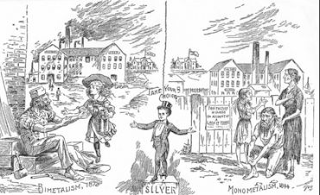As we hinted yesterday, the real problem with fractional
reserve banking is not that it permits commercial or mercantile banks to create
money. That is what such banks — a
combination of banks of issue and banks of discount — were invented to do. No, the problem is more subtle than that.
 |
| Medieval Banking: Making Loans |
Let’s take a scenario.
Assume that a bank opens for business with $1 million in capitalization
and deposits. The legally mandated
fractional reserve requirement is 20%.
What does the bank do?
Assuming that the bank’s loan officers are being prudent
within the established framework, they will make $5 million worth of loans as
fast as they can. Anything less means
that the bank has idle cash in the form of excess reserves, which it may or may
not be able to lend to other banks that are short of reserves.
 |
| Institution of Glass-Steagall in 1933. |
By the way, we’re also assuming that Glass-Steagall or something
similar is in operation, and the bank can’t go and put its excess reserves into
the stock market where the speculative returns tend to be greater than are
generally realized through the business of making commercial loans. No, the only thing this bank can do is make
loans, take deposits, discount bills, and issue promissory notes.
You see the problem, of course. A loan officer who doesn’t make loans up to
the maximum is costing the bank money, and that will probably cost him or her
that job. It is irrelevant whether there
is less than $5 million in feasible loans, or much more. The target is $5 million in loans.
Of course, a loan officer will do due diligence of a sort to
verify that it is a “good” loan. In the
back of his or her mind, however, will always be the urge to fudge a little,
especially if upper management or some government agency is putting on the
pressure to make certain types of loans that the bank ordinarily wouldn’t
touch. Many experts blame the home
mortgage meltdown on this tendency to fudge a little, and start down the
slippery slope of making loans based on something other than financial
feasibility.
There is also the danger that reserves will be used for
purposes other than intended if a bank is permitted to own shares other than
its own stock. That is what happened
with the repeal of Glass-Steagall and the merging of commercial and investment
banking functions. Instead of making
commercial loans, banks will be tempted to go into the stock market, driving up
prices and giving the illusion of economic growth when, in fact, the economy is
actually stagnant or even contracting.
 |
| "Money Famine" during the Great Depression of 1893-1898. |
It can go the other way, too. Feasible projects will go begging for
financing if the bank has already maxed out on the amount of loans it can make
constrained by the fractional reserve requirement. Economic growth will be unnecessarily
restricted, and a contraction of reserves can even trigger a financial panic
and a depression.
This happened in 1893, when foreign investors demanded
massive liquidation of American investments and required payment in gold — the
National Bank Notes, the reserve currency of the National Bank System, were of
no use to foreign investors. Gold
reserves plummeted, and banks began calling loans due to the bank not having
sufficient reserves to cover the loans.
Companies that had been “blue chip” only weeks before found themselves
insolvent, and the Panic of 1893 was in full swing, followed by the Great
Depression of 1893-1898.
 |
| "Keep Off the Grass" |
The Panic of 1893 and the following Great Depression, by the
way, provided the impetus for the development of conspiracy theory; this gave
birth to the legend of “the Crime of ’73.”
Not understanding the role of reserves or how banks operate, many people
believed that “international bankers” were behind the lack of money and the
widespread unemployment, and it was necessary for government to assume control
over the whole of the money supply and start creating jobs.
The
demands of “Coxey’s Army” in 1894 were,
to all intents and purposes, a precursor of the New Deal — as many
recognized
when on May 1, 1944 Jacob Coxey gave the speech from the Capitol steps
he had
been prevented from giving in 1894 — being arrested for walking on the
lawn, making "Keep Off the Grass" a populist political slogan. The
various "armies" that converged in protest marches on the nation's
capital also gave us incomprehensible-to-modern ears aphorisms, e.g., "Enough food to feed Coxey's Army," "Hungry as Coxey's Army," "Ragged as Coxey's Army," "Dirty as Coxey's Army," and so on.
So, the big problem with fractional reserve banking is that
it alternately encourages bad loans and prevents good loans. This is not an insurmountable problem,
however, as we will see next week.
